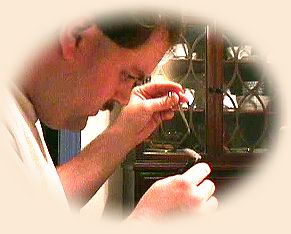|
Lunchtime = fishing time as the summer begins to
roll around. I had been down on the river yesterday,
but the water had been really stained. Still, I
figured I'd drop in and see what things looked like.
I pulled the car up onto the grass and took a look
over the water. A little clearer than yesterday,
but still stained. What the heck. I got the gear
out of the trunk and rigged up a minnow pattern that
I've been playing with. A few casts at the upper
pool below the dam got one short strike from a 12"
smallie. When I couldn't raise the fish for a second
strike, I headed downstream.
This time of year is always a mixed blessing for
fishing this section of the Conestoga. If the water
is clear, the fish are getting on the spawn, the big
fish move in closer and you get a shot at some good
fish. On the down side, the bank is overgrown with
brush and trees and it's often difficult to get to
the water and virtually impossible to cast. There
are beaten down sections of bank where access is
easier, and as a result, they're also the most
heavily pressured area.
The structure of the west bank here is interesting.
The middle and east bank of the river are pretty
consistent for depth, uniform rock size, and fairly
flat. The west bank has a ridge of rocks that rises
up from the middle of the river, drops quickly into
a trough about 5 feet offshore, and then climbs up
the bank. When the water is stained, the larger bass
will often sneak out of the deeper middle water to
settle in the shoreline channel and ambush panfish
and minnows. I pitched and roll cast the minnow out
into the current, letting it sink and swing, trying
to get down near the bottom to compensate for the
6-12" of visibility.
Out in the center of the river, fish rose splashily
to chase down the light blue damsels that glided
over the surface. No way to roll a cast out that
far with surrounding foliage. I moved down to another
small gap in the brush, throwing short 10' roll casts
out over the undulating weeds. I'd let the minnow
drift down behind the weedline, twitching it back up
to the surface against the flow of the current.
Another splashy rise in the middle of the river
distracted me as I rolled another messy cast out
over the water. Instead of a flitting damselfly,
a small minnow flew out of the water, a sizable
bass in hot pursuit. Everywhere the minnow re-entered
the water, a good sized boil would swirl up and the
silvery fish would launch out of the water again.
After 3 or 4 swirls, the action stopped, one of
the fish getting the better of the other. I'm
guessing it wasn't the minnow that came out on
the winning end. Well, if the fish are willing
to come up and chase bait that aggressively, I
decided that maybe it was time to alter my
fishing approach. The minnow had just swung past
the end of the weeds, and I gave it a couple of
quick, dancing strips as I watched for more
evidence of fish feeding outside my casting
range. I stripped the minnow again, and the
erratic dance of the fly was interrupted by a
swirling flash of green and bronze. I let the
line slip quickly from my fingers after I strip
set the hook, sensing from the solid resistance
of the hookset that this was a good fish.
The line slid away quickly, and the fish was on
the reel. As soon as the drag engaged the fish
bolted, peeling off 30 feet of line before
launching, body shaking, into the air.
Oh yeah, good fish. Good fish! I worked the rod
with a gentle touch. Not much room to either side
of me to work the angles, so I had to keep the rod
tip high, working the drag and palming the spool
to keep pressure on the fish. The fish gave two
more jumps, twisting and turning in the air. She
burrowed deep into a strand of weeds, as I tried
to lean back and pull her up short. I was glad
for the 8# tippet as I kept constant pressure on
the line and felt the fish slide free. She rolled
up along the shore and after a couple more lunges
toward deep water, came to hand. I lifted the fish
out of the water just enough to slip the hook free
when I noticed a length of heavy mono sticking out
of the fish' mouth. The mono disappeared down into
the gullet, so I took my nippers and cut the line
as deeply down as I could reach.
A quick measure against the rod butt showed the fish
ran about 17-18", which is fairly large for this
section of the river, with a fat, pre-spawn belly.
Probably close to 3 pounds, she'll be a solid two
pounder after the spawn. I held her in the water,
running her into the current, and then holding
lightly on the lip. After a couple of minutes
she wrested loose of my hold and shot off for
the safety of the depths.
Didn't get another hit the rest of the hour,
and it didn't bother me in the least. ~ Jason
|



